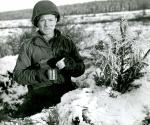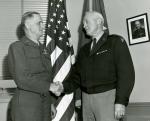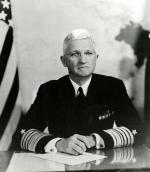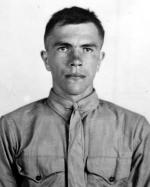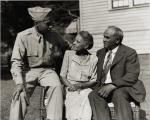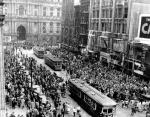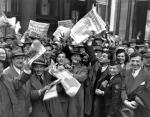Chapter 2: Pennsylvanians at War
From 1941 to 1945, more than 1.25 million Pennsylvanians served in America's armed forces, including more than 22,000 women, who volunteered to the new units in which they were allowed to serve, including WASP (Women Air Service Pilots), WAC (Women's Army Corps), SPAR (Coast Guard Auxiliary), WAVE (Women Accepted for Voluntary Enlistment-the Navy), and the Marines. More than 33,000 Pennsylvanians died on battlefields and in hospitals in Asia, Europe, and North Africa, and on the Atlantic and Pacific Oceans. Thirty-three Pennsylvanians were awarded the Congressional Medal of Honor, including  Mitchell Paige from Charleloi, the second most from any state.
Mitchell Paige from Charleloi, the second most from any state.
The Commonwealth was well represented among the top generals who planned the strategy that defeated the Axis powers. General of the Army George C. Marshall, born in Uniontown, was the Army Chief of Staff responsible for both modernizing and quickly enlarging the army, which at one time in the late 1930s was ranked nineteenth in the world. By late 1945, when World War II ended, more than 8.5 million Americans had served their country in uniform, a tremendous achievement.
George C. Marshall, born in Uniontown, was the Army Chief of Staff responsible for both modernizing and quickly enlarging the army, which at one time in the late 1930s was ranked nineteenth in the world. By late 1945, when World War II ended, more than 8.5 million Americans had served their country in uniform, a tremendous achievement.
The Army Air Force was led by Henry H. "Hap" Arnold, born in suburban Philadelphia and one of the first four army aviators in 1911. A proponent of heavy bombers, Arnold was largely responsible for the huge fleet of B-17s, B-24s, and B-29s that commanded the skies over Germany and Japan. Arnold's chief subordinate was another Pennsylvanian, Carl Spaatz, a Berks County Dutchman who rose to command the "Mighty Eighth" Air Force and then all strategic bombing in Europe and the Pacific.
Carl Spaatz, a Berks County Dutchman who rose to command the "Mighty Eighth" Air Force and then all strategic bombing in Europe and the Pacific.
Born in Emporium, General Joseph T. McNarney served as Deputy Chief of Staff, led the reorganization of the army in 1942, and then commanded Allied forces in the Mediterranean theater of operations. After holding a number of combat commands, General Lewis H. Brereton, from Pittsburgh, late in the summer of 1944 took command of the first Allied airborne army, which included American, British, and Polish paratroopers.
Two of Brereton's chief subordinates were also Pennsylvanians: Matthew B. Ridgway was the original chief of the famed 82nd Airborne Division and later a corps commander, while his second-in-command of the 82nd,
Matthew B. Ridgway was the original chief of the famed 82nd Airborne Division and later a corps commander, while his second-in-command of the 82nd,  "Slim Jim" Gavin led the division at war's end. Other famed Keystone generals included
"Slim Jim" Gavin led the division at war's end. Other famed Keystone generals included  Jacob L. Devers(York), commander of the Sixth Army Group in Europe; Alexander Patch (Lebanon), Seventh Army commander under Devers; and Lyman L. Lemnitzer (Honesdale), deputy chief of staff of the army operating in Italy. In all, roughly one hundred generals from the Keystone State served in all theaters of the war.
Jacob L. Devers(York), commander of the Sixth Army Group in Europe; Alexander Patch (Lebanon), Seventh Army commander under Devers; and Lyman L. Lemnitzer (Honesdale), deputy chief of staff of the army operating in Italy. In all, roughly one hundred generals from the Keystone State served in all theaters of the war.
Pennsylvania was also well represented at sea. The Navy contained twenty-nine admirals and four Marine Corps generals. Chief of Naval Operations at the beginning of the war, Harold R. Stark of Wilkes-Barre went to Europe to command the American naval presence there. Vice Admiral Alan G. Kirk of Philadelphia led the amphibious forces in the D-Day landings in Sicily, Italy, and Normandy. Admiral Richard S. Edwards, from Philadelphia, served as second-in-command of the Navy throughout the conflict, reporting to Ernest J. King, the Navy's supreme commander.
Soldiers of lesser rank came from all corners of the Keystone State and served honorably during the war. Nicknamed the "Bloody Bucket" in honor of its fierceness, the Pennsylvania 28th Division fought in some of the bloodiest battles of Europe.
Its casualties included 2,316 men killed in action, 9,609 wounded, and 367 who died from their wounds. One of the best-known junior officers was Erie's Colonel
28th Division fought in some of the bloodiest battles of Europe.
Its casualties included 2,316 men killed in action, 9,609 wounded, and 367 who died from their wounds. One of the best-known junior officers was Erie's Colonel Phil Cochran, the hot-shot leader of the "Joker Squadron" in North Africa and later the commander of the 1st Air Commando Group, which supplied the means for airlifting British troops behind Japanese lines in Burma later in the war.
Phil Cochran, the hot-shot leader of the "Joker Squadron" in North Africa and later the commander of the 1st Air Commando Group, which supplied the means for airlifting British troops behind Japanese lines in Burma later in the war.
On bloody Iwo Jima in the Pacific, one of the Marines who raised the Stars and Stripes on Mount Suribachi was Sergeant Michael Strank, the son of immigrant Czechs who had settled in Cambria County. Strank led the patrol that raised the second, larger flag that fateful day in February 1945, a deed made famous by Associated Press photographer Joe Rosenthal. Sadly, Strank and two other Marines in the photo were killed before Americans had secured the island.
Michael Strank, the son of immigrant Czechs who had settled in Cambria County. Strank led the patrol that raised the second, larger flag that fateful day in February 1945, a deed made famous by Associated Press photographer Joe Rosenthal. Sadly, Strank and two other Marines in the photo were killed before Americans had secured the island.
African Americans from Pennsylvania also served, but in segregated units. The armed forces, following the social mores of the time, segregated African Americans into all-black units commanded by white officers. As a result, African Americans who either volunteered or were drafted wound up in two infantry divisions (92nd and 93rd) and a host of supporting units ranging from artillery and tank battalions to engineer groups and a number of service units that kept the supplies going to the front, including the "Red Ball Express," which logged thousands of miles in France running supplies to George S. Patton's Third Army.
African Americans also had their own newspaper correspondents, who took pride in reporting black achievements, limited though they might be. Of the twenty-seven regular reporters, Frank Bolden of the Pittsburgh Courier became one of the most famous, for his reports from Iran and Burma, and interviews with Josef Stalin, Chiang Kai-Shek, Mahatma Gandhi, Jawaharlal Nehru, and other world leaders.
Frank Bolden of the Pittsburgh Courier became one of the most famous, for his reports from Iran and Burma, and interviews with Josef Stalin, Chiang Kai-Shek, Mahatma Gandhi, Jawaharlal Nehru, and other world leaders.
Pennsylvanians also played important roles in the development of post-war Europe. General Marshall, as Secretary of State under President Truman, helped implement the "Marshall Plan," by which the United States provided much-needed economic relief to a battered Europe, including former enemies Germany and Italy. General Homer M. Groninger (Juniata County) succeeded General Dwight D. Eisenhower as commander of the American occupation zone in Germany.
Associate Justice of the Supreme Court Robert H. Jackson served as chief American prosecutor of Nazis charged with war crimes. Under Jackson's direction, American, British, French, and Soviet prosecutors gathered evidence and presented their findings during the 1945-1946 trials held in Nuremberg, Germany. Jackson's decisions at Nuremberg would help form the basis of a new branch of international law dealing with crimes against both civilians and other countries.
Robert H. Jackson served as chief American prosecutor of Nazis charged with war crimes. Under Jackson's direction, American, British, French, and Soviet prosecutors gathered evidence and presented their findings during the 1945-1946 trials held in Nuremberg, Germany. Jackson's decisions at Nuremberg would help form the basis of a new branch of international law dealing with crimes against both civilians and other countries.
The Commonwealth was well represented among the top generals who planned the strategy that defeated the Axis powers. General of the Army
The Army Air Force was led by Henry H. "Hap" Arnold, born in suburban Philadelphia and one of the first four army aviators in 1911. A proponent of heavy bombers, Arnold was largely responsible for the huge fleet of B-17s, B-24s, and B-29s that commanded the skies over Germany and Japan. Arnold's chief subordinate was another Pennsylvanian,
Born in Emporium, General Joseph T. McNarney served as Deputy Chief of Staff, led the reorganization of the army in 1942, and then commanded Allied forces in the Mediterranean theater of operations. After holding a number of combat commands, General Lewis H. Brereton, from Pittsburgh, late in the summer of 1944 took command of the first Allied airborne army, which included American, British, and Polish paratroopers.
Two of Brereton's chief subordinates were also Pennsylvanians:
Pennsylvania was also well represented at sea. The Navy contained twenty-nine admirals and four Marine Corps generals. Chief of Naval Operations at the beginning of the war, Harold R. Stark of Wilkes-Barre went to Europe to command the American naval presence there. Vice Admiral Alan G. Kirk of Philadelphia led the amphibious forces in the D-Day landings in Sicily, Italy, and Normandy. Admiral Richard S. Edwards, from Philadelphia, served as second-in-command of the Navy throughout the conflict, reporting to Ernest J. King, the Navy's supreme commander.
Soldiers of lesser rank came from all corners of the Keystone State and served honorably during the war. Nicknamed the "Bloody Bucket" in honor of its fierceness, the Pennsylvania
On bloody Iwo Jima in the Pacific, one of the Marines who raised the Stars and Stripes on Mount Suribachi was Sergeant
African Americans from Pennsylvania also served, but in segregated units. The armed forces, following the social mores of the time, segregated African Americans into all-black units commanded by white officers. As a result, African Americans who either volunteered or were drafted wound up in two infantry divisions (92nd and 93rd) and a host of supporting units ranging from artillery and tank battalions to engineer groups and a number of service units that kept the supplies going to the front, including the "Red Ball Express," which logged thousands of miles in France running supplies to George S. Patton's Third Army.
African Americans also had their own newspaper correspondents, who took pride in reporting black achievements, limited though they might be. Of the twenty-seven regular reporters,
Pennsylvanians also played important roles in the development of post-war Europe. General Marshall, as Secretary of State under President Truman, helped implement the "Marshall Plan," by which the United States provided much-needed economic relief to a battered Europe, including former enemies Germany and Italy. General Homer M. Groninger (Juniata County) succeeded General Dwight D. Eisenhower as commander of the American occupation zone in Germany.
Associate Justice of the Supreme Court









